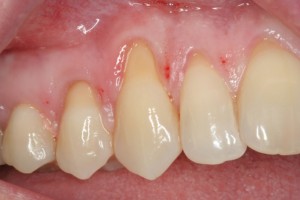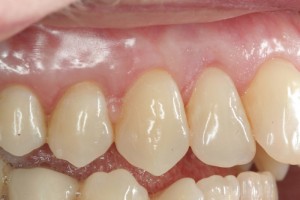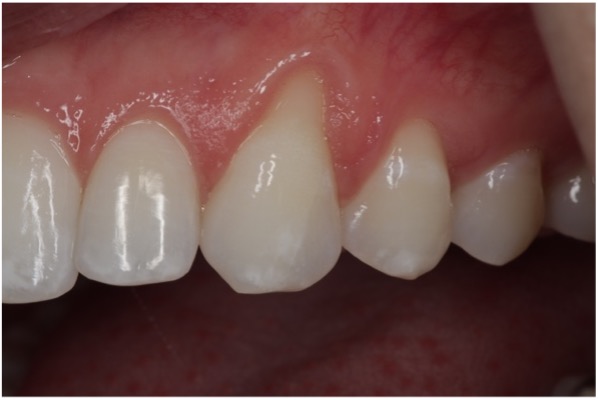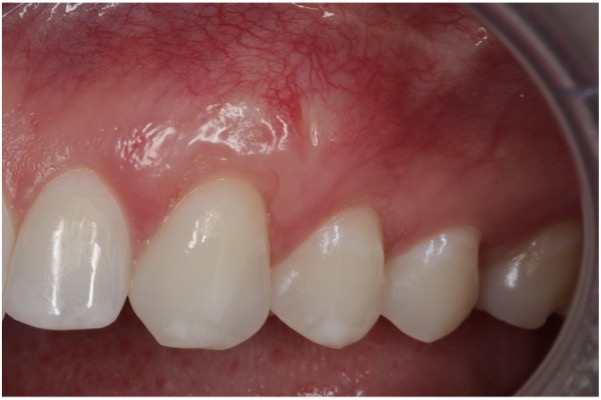Protect your teeth from decay,
reduce sensitivity and improve aesthetics
Gingival Augmentation (Gum Grafting)
Exposed tooth roots are the result of gum recession. Recession occurs for a number of reasons including aggressive tooth brushing or periodontal disease. Gum grafting will cover the exposed roots to protect them from decay, help reduce tooth sensitivity, and improve the aesthetics of your smile.
 Gingival Augmentation (Before) |
 Gingival Augmentation (After) |
Gum recession
Gum recession is caused by advanced gum disease. When gingivitis goes untreated, gum disease (also called periodontitis) will cause gums to pull away from the teeth, leaving deep pockets where bacteria can grow and damage the bone that supports the teeth. Gums can also shrink back from the teeth, making the teeth look longer. Teeth may then become loose, fall out, or have to be pulled out by a dentist.
Gum recession is a slow process and you may not even be aware that your gums have receded. However, without a gum tissue graft, recession can have a detrimental effect on the health and function of your teeth. The following are common among people whose gums are receding:
- Sensitivity to hot or cold temperatures, or even to sweet, spicy, or sour foods
- Teeth appear longer than normal
- Spaces between teeth are larger
- Roots of teeth begin to show
Gum tissue grafting
Gum graft surgery is available to stop gum recession and/or improve the look of your gum line. When your gums recede, the body loses a natural defense against bacteria and this can cause your teeth to be more prone to decay. You may also experience increased sensitivity and from an esthetic perspective, the appearance of your smile can be affected.
 Pre Surgery |
 Post Surgery |
During gum graft surgery, Dr. Tymkiw takes gum tissue from your palate or another donor source to cover the exposed root. This can be done for one tooth or several teeth to even-out your gum line and reduce sensitivity. Depending on your specific needs, we will perform one of three different types of gum tissue grafts.
Connective tissue grafts
The most common method to treat root exposure, connective tissue grafting involves cutting a flap of skin on the roof of your mouth (or palate) and removing tissue from under the flap, called sub-epithelial connective tissue. This tissue is then stitched to the gum tissue surrounding the exposed root. After the connective tissue, or graft, has been removed from under the flap, the flap is then stitched back down.
Free gingival grafts
Similar to a connective tissue grafting, a free gingival graft involves the use of tissue from the roof of the mouth. But instead of making a flap and removing tissue under the top layer of flesh, a small amount of tissue is removed directly from the roof of the mouth and then attached to the gum area being treated. This method is used most often in people who have thin gums to begin with and need additional tissue to enlarge the gums.
Pedicle grafts
In this procedure, instead of taking tissue from the palate, it is grafted from gum around or near the tooth needing repair. The flap, called a pedicle, is only partially cut away so that one edge remains attached. The gum is then pulled over or down to cover the exposed root and sewn into place. This procedure can only be done if you have plenty of gum tissue near the tooth.
Many factors will contribute to your chosen grafting technique. Dr. Tymkiw will advise you you which method will work best for you, your health, and your smile.
You may experience some swelling after the surgery. Applying an ice pack to the outside of your face over the treated area can help with any discomfort. In some cases, antibiotics are given before, during, and after the treatment in order to prevent any infections. After a week or two, you’ll have a post-op check where Dr. Tymkiw will check the surgical area and make sure you are healing well and address any questions you may have.
A gum graft can reduce further recession and bone loss. In some cases, it can cover exposed roots to protect them from decay. This may reduce tooth sensitivity and improve esthetics of your smile. Whether you have a gum graft to improve function or esthetics, patients often receive the benefits of both: a beautiful new smile and improved periodontal health – your keys to smiling, eating and speaking with comfort and confidence.
Refer to Post Surgical Instructions for aftercare recommendations.


